EBN Research: Alcohol-Based Sanitizers for Infection Control
VerifiedAdded on 2023/06/08
|11
|2339
|414
Report
AI Summary
This report presents an evidence-based investigation into infection control practices within the Australian healthcare system, focusing on the effectiveness of alcohol-based sanitizers compared to traditional soap and water for hand hygiene in reducing hospital-acquired infections (HAIs). The research highlights the significant burden of HAIs on healthcare expenditure and the critical role of nurses in preventing their spread. Personal reflection reveals a concern over the lack of standardized infection control protocols and the need for comparative research to promote the use of alcohol-based sanitizers. The study aims to discover the advantage of using alcohol based sanitizers as compared to normal soap and water in hand hygiene to avoid the risk of hospital acquired infections. A search strategy using the SCOPUS database identified three relevant articles, including a cross-sectional study demonstrating reduced HAI rates with alcohol rubs, a longitudinal study showing decreased HAIs with an infection control program emphasizing alcohol-based sanitizers, and an observational study indicating improved compliance with sanitizer use through strategic placement and signage. The findings suggest that integrating alcohol-based sanitizers into comprehensive hand hygiene programs can significantly reduce HAI rates and improve compliance among healthcare workers and visitors.
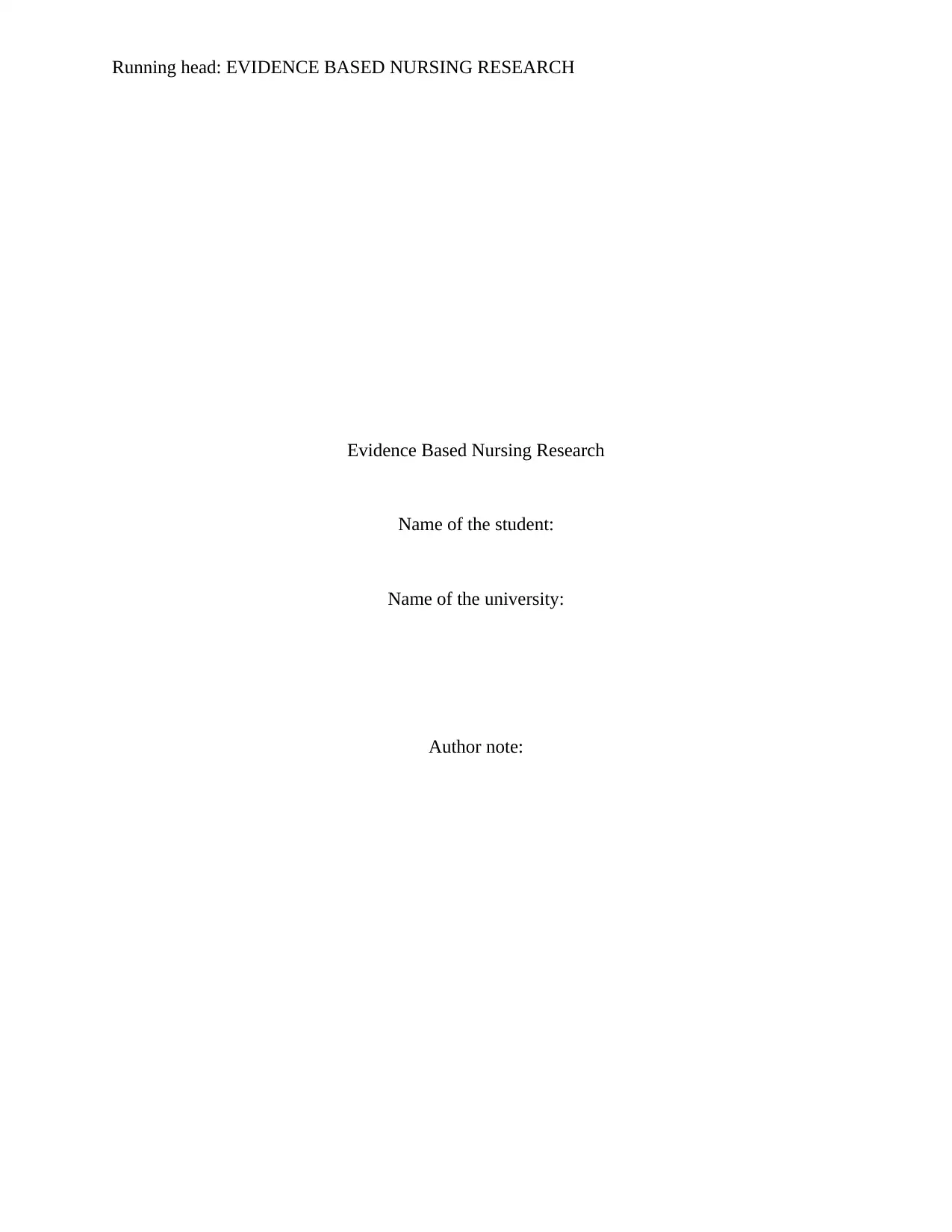
Running head: EVIDENCE BASED NURSING RESEARCH
Evidence Based Nursing Research
Name of the student:
Name of the university:
Author note:
Evidence Based Nursing Research
Name of the student:
Name of the university:
Author note:
Paraphrase This Document
Need a fresh take? Get an instant paraphrase of this document with our AI Paraphraser
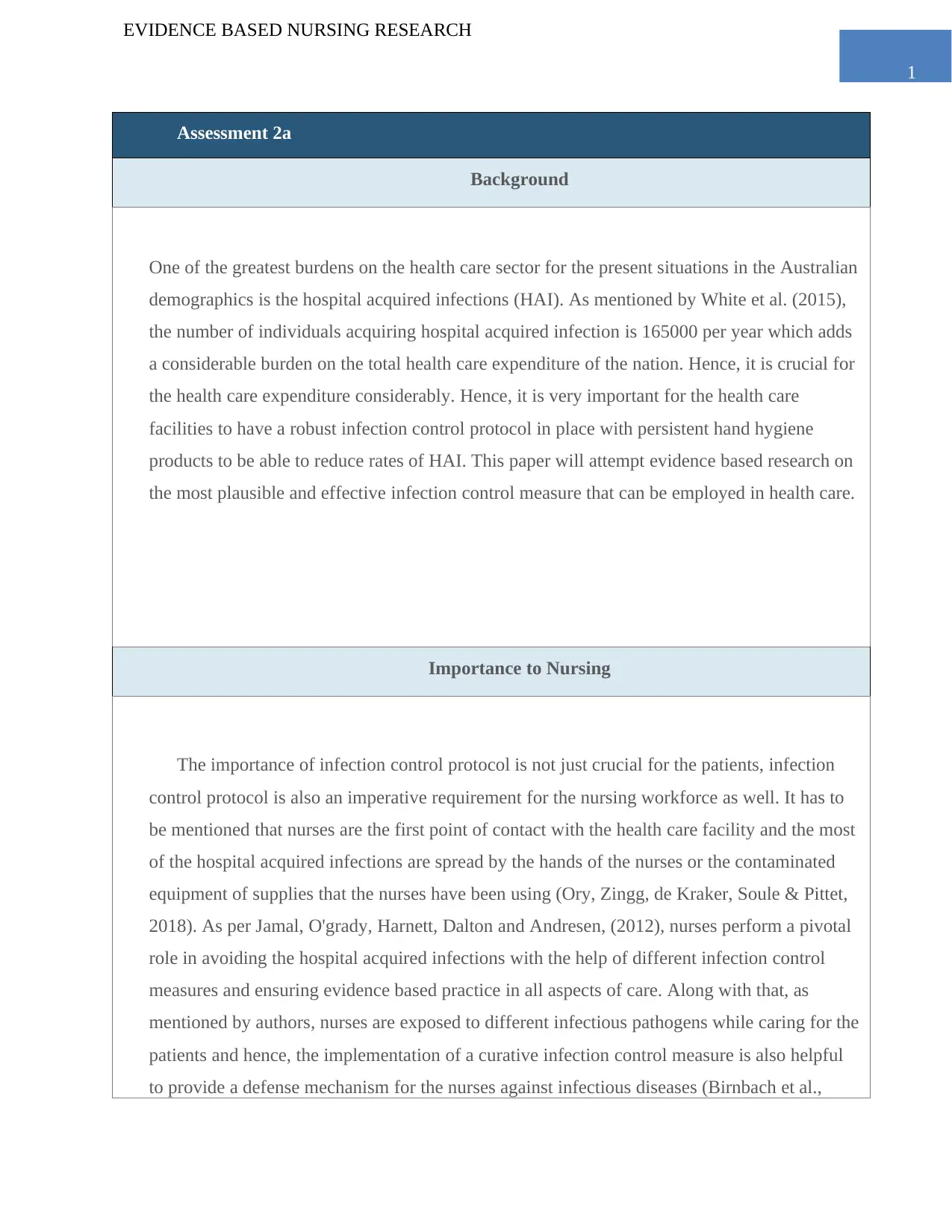
1
EVIDENCE BASED NURSING RESEARCH
Assessment 2a
Background
One of the greatest burdens on the health care sector for the present situations in the Australian
demographics is the hospital acquired infections (HAI). As mentioned by White et al. (2015),
the number of individuals acquiring hospital acquired infection is 165000 per year which adds
a considerable burden on the total health care expenditure of the nation. Hence, it is crucial for
the health care expenditure considerably. Hence, it is very important for the health care
facilities to have a robust infection control protocol in place with persistent hand hygiene
products to be able to reduce rates of HAI. This paper will attempt evidence based research on
the most plausible and effective infection control measure that can be employed in health care.
Importance to Nursing
The importance of infection control protocol is not just crucial for the patients, infection
control protocol is also an imperative requirement for the nursing workforce as well. It has to
be mentioned that nurses are the first point of contact with the health care facility and the most
of the hospital acquired infections are spread by the hands of the nurses or the contaminated
equipment of supplies that the nurses have been using (Ory, Zingg, de Kraker, Soule & Pittet,
2018). As per Jamal, O'grady, Harnett, Dalton and Andresen, (2012), nurses perform a pivotal
role in avoiding the hospital acquired infections with the help of different infection control
measures and ensuring evidence based practice in all aspects of care. Along with that, as
mentioned by authors, nurses are exposed to different infectious pathogens while caring for the
patients and hence, the implementation of a curative infection control measure is also helpful
to provide a defense mechanism for the nurses against infectious diseases (Birnbach et al.,
EVIDENCE BASED NURSING RESEARCH
Assessment 2a
Background
One of the greatest burdens on the health care sector for the present situations in the Australian
demographics is the hospital acquired infections (HAI). As mentioned by White et al. (2015),
the number of individuals acquiring hospital acquired infection is 165000 per year which adds
a considerable burden on the total health care expenditure of the nation. Hence, it is crucial for
the health care expenditure considerably. Hence, it is very important for the health care
facilities to have a robust infection control protocol in place with persistent hand hygiene
products to be able to reduce rates of HAI. This paper will attempt evidence based research on
the most plausible and effective infection control measure that can be employed in health care.
Importance to Nursing
The importance of infection control protocol is not just crucial for the patients, infection
control protocol is also an imperative requirement for the nursing workforce as well. It has to
be mentioned that nurses are the first point of contact with the health care facility and the most
of the hospital acquired infections are spread by the hands of the nurses or the contaminated
equipment of supplies that the nurses have been using (Ory, Zingg, de Kraker, Soule & Pittet,
2018). As per Jamal, O'grady, Harnett, Dalton and Andresen, (2012), nurses perform a pivotal
role in avoiding the hospital acquired infections with the help of different infection control
measures and ensuring evidence based practice in all aspects of care. Along with that, as
mentioned by authors, nurses are exposed to different infectious pathogens while caring for the
patients and hence, the implementation of a curative infection control measure is also helpful
to provide a defense mechanism for the nurses against infectious diseases (Birnbach et al.,
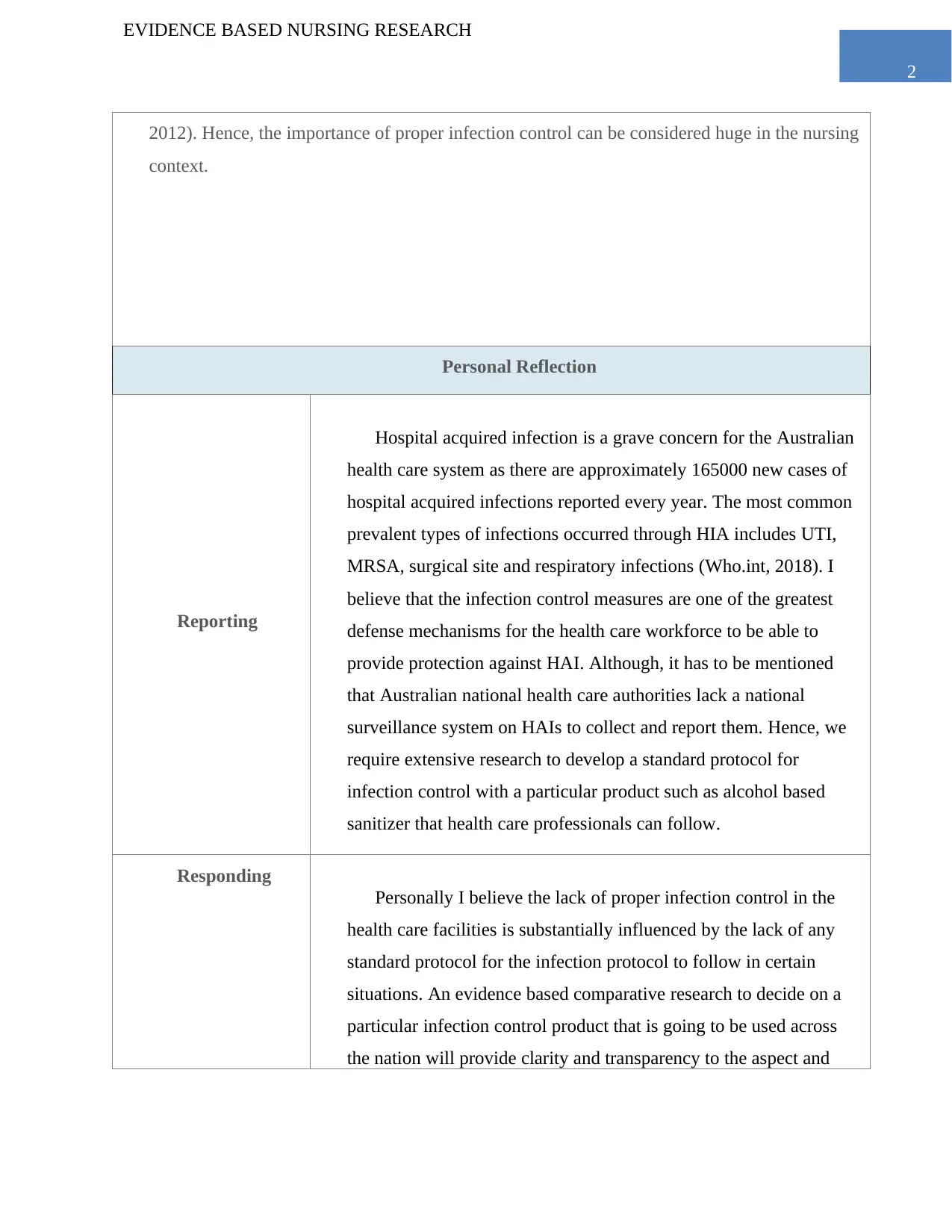
2
EVIDENCE BASED NURSING RESEARCH
2012). Hence, the importance of proper infection control can be considered huge in the nursing
context.
Personal Reflection
Reporting
Hospital acquired infection is a grave concern for the Australian
health care system as there are approximately 165000 new cases of
hospital acquired infections reported every year. The most common
prevalent types of infections occurred through HIA includes UTI,
MRSA, surgical site and respiratory infections (Who.int, 2018). I
believe that the infection control measures are one of the greatest
defense mechanisms for the health care workforce to be able to
provide protection against HAI. Although, it has to be mentioned
that Australian national health care authorities lack a national
surveillance system on HAIs to collect and report them. Hence, we
require extensive research to develop a standard protocol for
infection control with a particular product such as alcohol based
sanitizer that health care professionals can follow.
Responding
Personally I believe the lack of proper infection control in the
health care facilities is substantially influenced by the lack of any
standard protocol for the infection protocol to follow in certain
situations. An evidence based comparative research to decide on a
particular infection control product that is going to be used across
the nation will provide clarity and transparency to the aspect and
EVIDENCE BASED NURSING RESEARCH
2012). Hence, the importance of proper infection control can be considered huge in the nursing
context.
Personal Reflection
Reporting
Hospital acquired infection is a grave concern for the Australian
health care system as there are approximately 165000 new cases of
hospital acquired infections reported every year. The most common
prevalent types of infections occurred through HIA includes UTI,
MRSA, surgical site and respiratory infections (Who.int, 2018). I
believe that the infection control measures are one of the greatest
defense mechanisms for the health care workforce to be able to
provide protection against HAI. Although, it has to be mentioned
that Australian national health care authorities lack a national
surveillance system on HAIs to collect and report them. Hence, we
require extensive research to develop a standard protocol for
infection control with a particular product such as alcohol based
sanitizer that health care professionals can follow.
Responding
Personally I believe the lack of proper infection control in the
health care facilities is substantially influenced by the lack of any
standard protocol for the infection protocol to follow in certain
situations. An evidence based comparative research to decide on a
particular infection control product that is going to be used across
the nation will provide clarity and transparency to the aspect and
⊘ This is a preview!⊘
Do you want full access?
Subscribe today to unlock all pages.

Trusted by 1+ million students worldwide
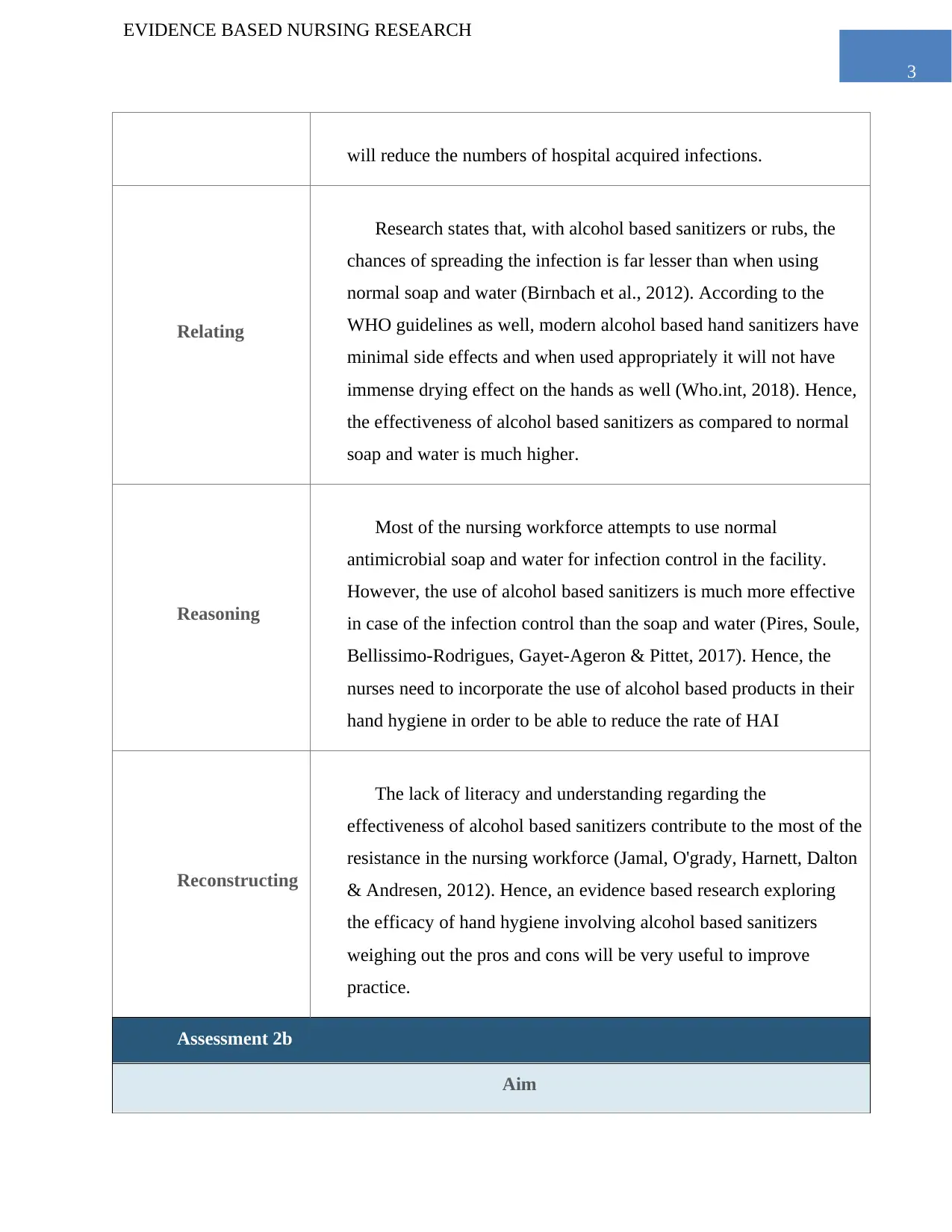
3
EVIDENCE BASED NURSING RESEARCH
will reduce the numbers of hospital acquired infections.
Relating
Research states that, with alcohol based sanitizers or rubs, the
chances of spreading the infection is far lesser than when using
normal soap and water (Birnbach et al., 2012). According to the
WHO guidelines as well, modern alcohol based hand sanitizers have
minimal side effects and when used appropriately it will not have
immense drying effect on the hands as well (Who.int, 2018). Hence,
the effectiveness of alcohol based sanitizers as compared to normal
soap and water is much higher.
Reasoning
Most of the nursing workforce attempts to use normal
antimicrobial soap and water for infection control in the facility.
However, the use of alcohol based sanitizers is much more effective
in case of the infection control than the soap and water (Pires, Soule,
Bellissimo-Rodrigues, Gayet-Ageron & Pittet, 2017). Hence, the
nurses need to incorporate the use of alcohol based products in their
hand hygiene in order to be able to reduce the rate of HAI
Reconstructing
The lack of literacy and understanding regarding the
effectiveness of alcohol based sanitizers contribute to the most of the
resistance in the nursing workforce (Jamal, O'grady, Harnett, Dalton
& Andresen, 2012). Hence, an evidence based research exploring
the efficacy of hand hygiene involving alcohol based sanitizers
weighing out the pros and cons will be very useful to improve
practice.
Assessment 2b
Aim
EVIDENCE BASED NURSING RESEARCH
will reduce the numbers of hospital acquired infections.
Relating
Research states that, with alcohol based sanitizers or rubs, the
chances of spreading the infection is far lesser than when using
normal soap and water (Birnbach et al., 2012). According to the
WHO guidelines as well, modern alcohol based hand sanitizers have
minimal side effects and when used appropriately it will not have
immense drying effect on the hands as well (Who.int, 2018). Hence,
the effectiveness of alcohol based sanitizers as compared to normal
soap and water is much higher.
Reasoning
Most of the nursing workforce attempts to use normal
antimicrobial soap and water for infection control in the facility.
However, the use of alcohol based sanitizers is much more effective
in case of the infection control than the soap and water (Pires, Soule,
Bellissimo-Rodrigues, Gayet-Ageron & Pittet, 2017). Hence, the
nurses need to incorporate the use of alcohol based products in their
hand hygiene in order to be able to reduce the rate of HAI
Reconstructing
The lack of literacy and understanding regarding the
effectiveness of alcohol based sanitizers contribute to the most of the
resistance in the nursing workforce (Jamal, O'grady, Harnett, Dalton
& Andresen, 2012). Hence, an evidence based research exploring
the efficacy of hand hygiene involving alcohol based sanitizers
weighing out the pros and cons will be very useful to improve
practice.
Assessment 2b
Aim
Paraphrase This Document
Need a fresh take? Get an instant paraphrase of this document with our AI Paraphraser
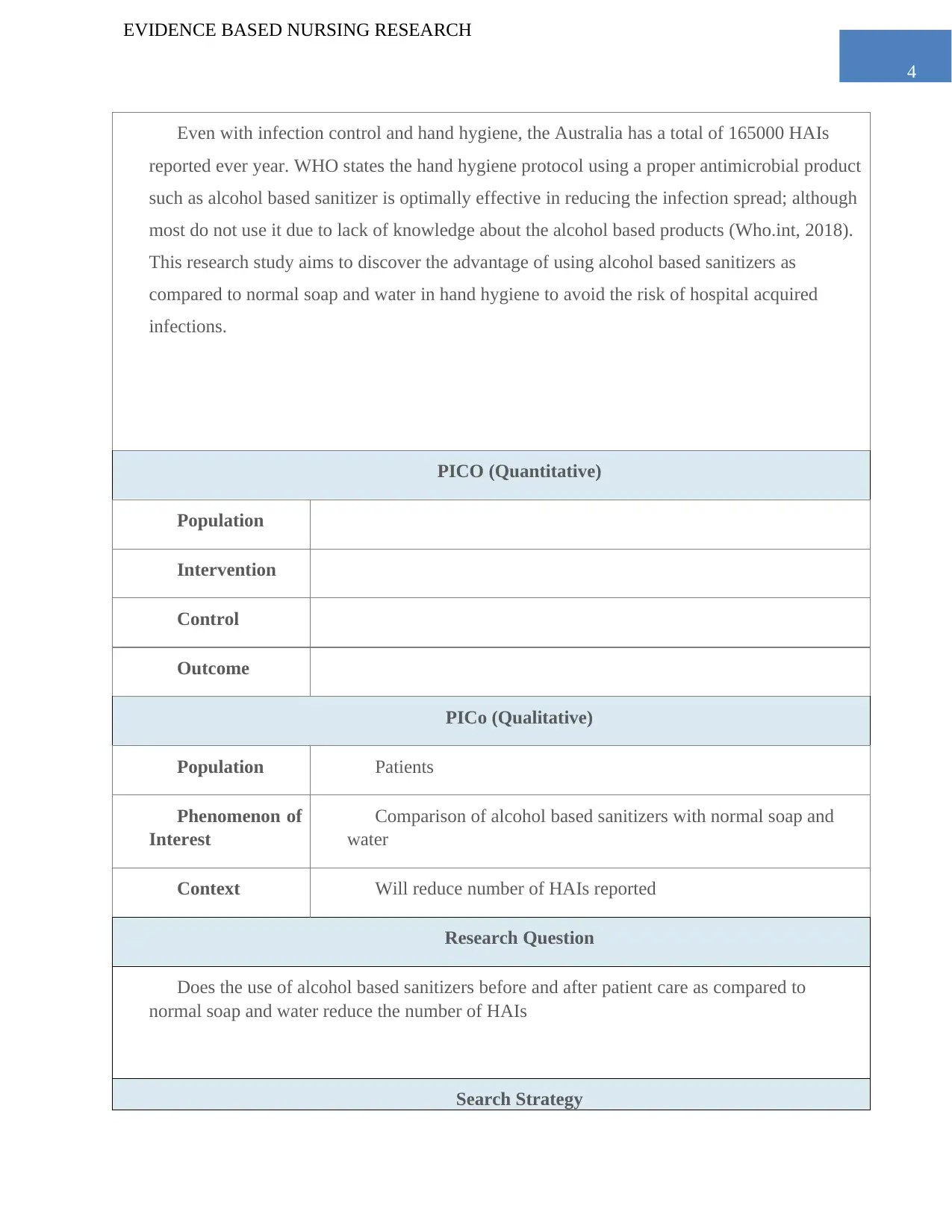
4
EVIDENCE BASED NURSING RESEARCH
Even with infection control and hand hygiene, the Australia has a total of 165000 HAIs
reported ever year. WHO states the hand hygiene protocol using a proper antimicrobial product
such as alcohol based sanitizer is optimally effective in reducing the infection spread; although
most do not use it due to lack of knowledge about the alcohol based products (Who.int, 2018).
This research study aims to discover the advantage of using alcohol based sanitizers as
compared to normal soap and water in hand hygiene to avoid the risk of hospital acquired
infections.
PICO (Quantitative)
Population
Intervention
Control
Outcome
PICo (Qualitative)
Population Patients
Phenomenon of
Interest
Comparison of alcohol based sanitizers with normal soap and
water
Context Will reduce number of HAIs reported
Research Question
Does the use of alcohol based sanitizers before and after patient care as compared to
normal soap and water reduce the number of HAIs
Search Strategy
EVIDENCE BASED NURSING RESEARCH
Even with infection control and hand hygiene, the Australia has a total of 165000 HAIs
reported ever year. WHO states the hand hygiene protocol using a proper antimicrobial product
such as alcohol based sanitizer is optimally effective in reducing the infection spread; although
most do not use it due to lack of knowledge about the alcohol based products (Who.int, 2018).
This research study aims to discover the advantage of using alcohol based sanitizers as
compared to normal soap and water in hand hygiene to avoid the risk of hospital acquired
infections.
PICO (Quantitative)
Population
Intervention
Control
Outcome
PICo (Qualitative)
Population Patients
Phenomenon of
Interest
Comparison of alcohol based sanitizers with normal soap and
water
Context Will reduce number of HAIs reported
Research Question
Does the use of alcohol based sanitizers before and after patient care as compared to
normal soap and water reduce the number of HAIs
Search Strategy
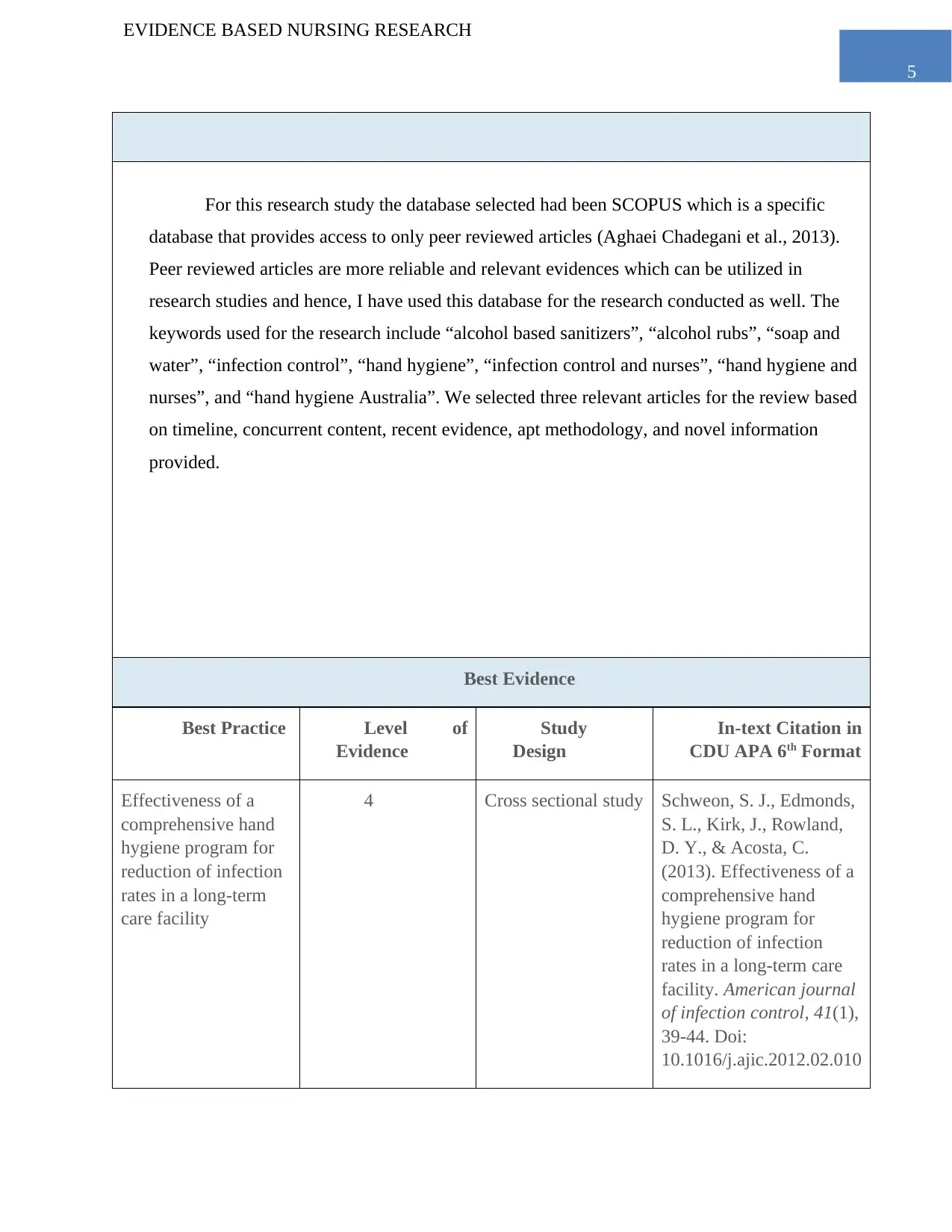
5
EVIDENCE BASED NURSING RESEARCH
For this research study the database selected had been SCOPUS which is a specific
database that provides access to only peer reviewed articles (Aghaei Chadegani et al., 2013).
Peer reviewed articles are more reliable and relevant evidences which can be utilized in
research studies and hence, I have used this database for the research conducted as well. The
keywords used for the research include “alcohol based sanitizers”, “alcohol rubs”, “soap and
water”, “infection control”, “hand hygiene”, “infection control and nurses”, “hand hygiene and
nurses”, and “hand hygiene Australia”. We selected three relevant articles for the review based
on timeline, concurrent content, recent evidence, apt methodology, and novel information
provided.
Best Evidence
Best Practice Level of
Evidence
Study
Design
In-text Citation in
CDU APA 6th Format
Effectiveness of a
comprehensive hand
hygiene program for
reduction of infection
rates in a long-term
care facility
4 Cross sectional study Schweon, S. J., Edmonds,
S. L., Kirk, J., Rowland,
D. Y., & Acosta, C.
(2013). Effectiveness of a
comprehensive hand
hygiene program for
reduction of infection
rates in a long-term care
facility. American journal
of infection control, 41(1),
39-44. Doi:
10.1016/j.ajic.2012.02.010
EVIDENCE BASED NURSING RESEARCH
For this research study the database selected had been SCOPUS which is a specific
database that provides access to only peer reviewed articles (Aghaei Chadegani et al., 2013).
Peer reviewed articles are more reliable and relevant evidences which can be utilized in
research studies and hence, I have used this database for the research conducted as well. The
keywords used for the research include “alcohol based sanitizers”, “alcohol rubs”, “soap and
water”, “infection control”, “hand hygiene”, “infection control and nurses”, “hand hygiene and
nurses”, and “hand hygiene Australia”. We selected three relevant articles for the review based
on timeline, concurrent content, recent evidence, apt methodology, and novel information
provided.
Best Evidence
Best Practice Level of
Evidence
Study
Design
In-text Citation in
CDU APA 6th Format
Effectiveness of a
comprehensive hand
hygiene program for
reduction of infection
rates in a long-term
care facility
4 Cross sectional study Schweon, S. J., Edmonds,
S. L., Kirk, J., Rowland,
D. Y., & Acosta, C.
(2013). Effectiveness of a
comprehensive hand
hygiene program for
reduction of infection
rates in a long-term care
facility. American journal
of infection control, 41(1),
39-44. Doi:
10.1016/j.ajic.2012.02.010
⊘ This is a preview!⊘
Do you want full access?
Subscribe today to unlock all pages.

Trusted by 1+ million students worldwide
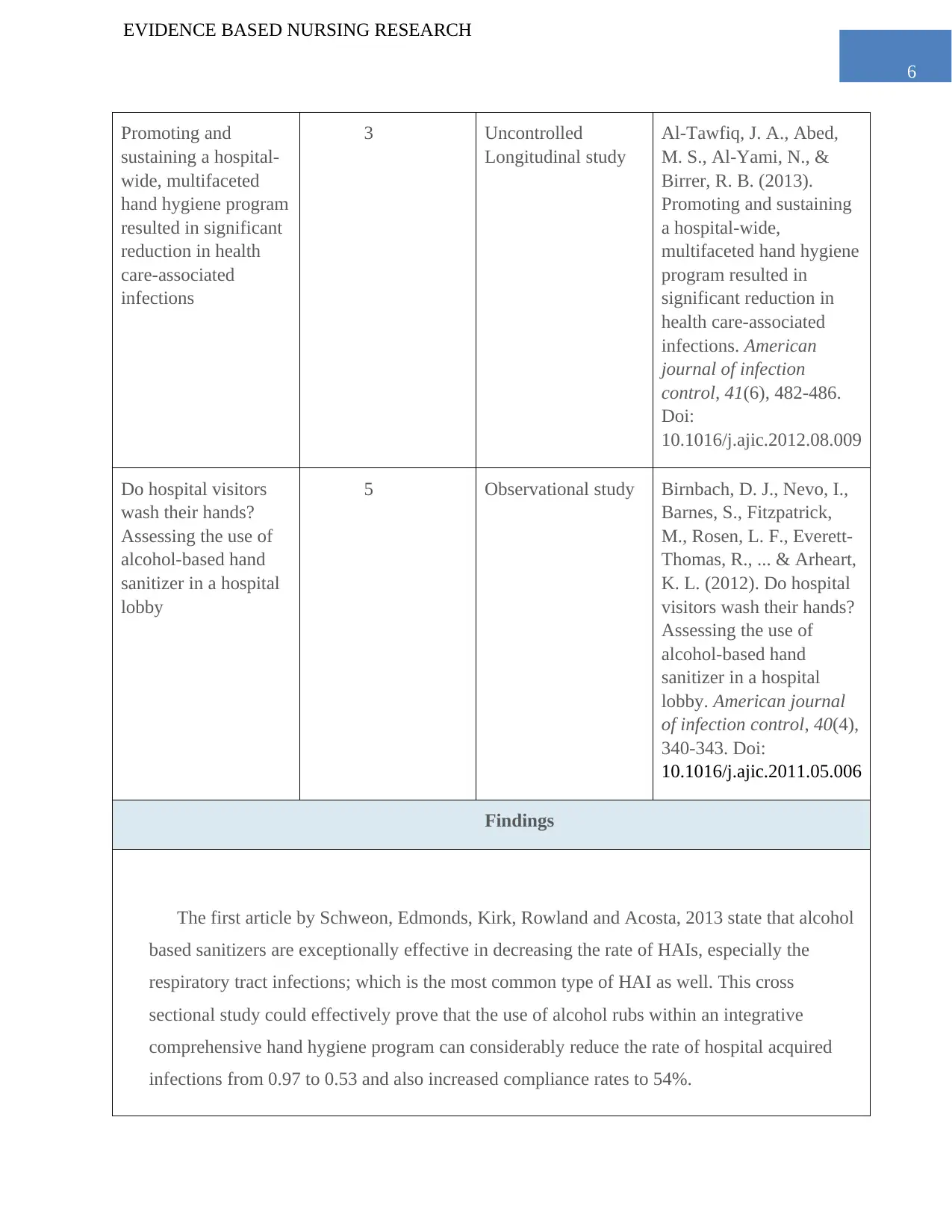
6
EVIDENCE BASED NURSING RESEARCH
Promoting and
sustaining a hospital-
wide, multifaceted
hand hygiene program
resulted in significant
reduction in health
care-associated
infections
3 Uncontrolled
Longitudinal study
Al-Tawfiq, J. A., Abed,
M. S., Al-Yami, N., &
Birrer, R. B. (2013).
Promoting and sustaining
a hospital-wide,
multifaceted hand hygiene
program resulted in
significant reduction in
health care-associated
infections. American
journal of infection
control, 41(6), 482-486.
Doi:
10.1016/j.ajic.2012.08.009
Do hospital visitors
wash their hands?
Assessing the use of
alcohol-based hand
sanitizer in a hospital
lobby
5 Observational study Birnbach, D. J., Nevo, I.,
Barnes, S., Fitzpatrick,
M., Rosen, L. F., Everett-
Thomas, R., ... & Arheart,
K. L. (2012). Do hospital
visitors wash their hands?
Assessing the use of
alcohol-based hand
sanitizer in a hospital
lobby. American journal
of infection control, 40(4),
340-343. Doi:
10.1016/j.ajic.2011.05.006
Findings
The first article by Schweon, Edmonds, Kirk, Rowland and Acosta, 2013 state that alcohol
based sanitizers are exceptionally effective in decreasing the rate of HAIs, especially the
respiratory tract infections; which is the most common type of HAI as well. This cross
sectional study could effectively prove that the use of alcohol rubs within an integrative
comprehensive hand hygiene program can considerably reduce the rate of hospital acquired
infections from 0.97 to 0.53 and also increased compliance rates to 54%.
EVIDENCE BASED NURSING RESEARCH
Promoting and
sustaining a hospital-
wide, multifaceted
hand hygiene program
resulted in significant
reduction in health
care-associated
infections
3 Uncontrolled
Longitudinal study
Al-Tawfiq, J. A., Abed,
M. S., Al-Yami, N., &
Birrer, R. B. (2013).
Promoting and sustaining
a hospital-wide,
multifaceted hand hygiene
program resulted in
significant reduction in
health care-associated
infections. American
journal of infection
control, 41(6), 482-486.
Doi:
10.1016/j.ajic.2012.08.009
Do hospital visitors
wash their hands?
Assessing the use of
alcohol-based hand
sanitizer in a hospital
lobby
5 Observational study Birnbach, D. J., Nevo, I.,
Barnes, S., Fitzpatrick,
M., Rosen, L. F., Everett-
Thomas, R., ... & Arheart,
K. L. (2012). Do hospital
visitors wash their hands?
Assessing the use of
alcohol-based hand
sanitizer in a hospital
lobby. American journal
of infection control, 40(4),
340-343. Doi:
10.1016/j.ajic.2011.05.006
Findings
The first article by Schweon, Edmonds, Kirk, Rowland and Acosta, 2013 state that alcohol
based sanitizers are exceptionally effective in decreasing the rate of HAIs, especially the
respiratory tract infections; which is the most common type of HAI as well. This cross
sectional study could effectively prove that the use of alcohol rubs within an integrative
comprehensive hand hygiene program can considerably reduce the rate of hospital acquired
infections from 0.97 to 0.53 and also increased compliance rates to 54%.
Paraphrase This Document
Need a fresh take? Get an instant paraphrase of this document with our AI Paraphraser
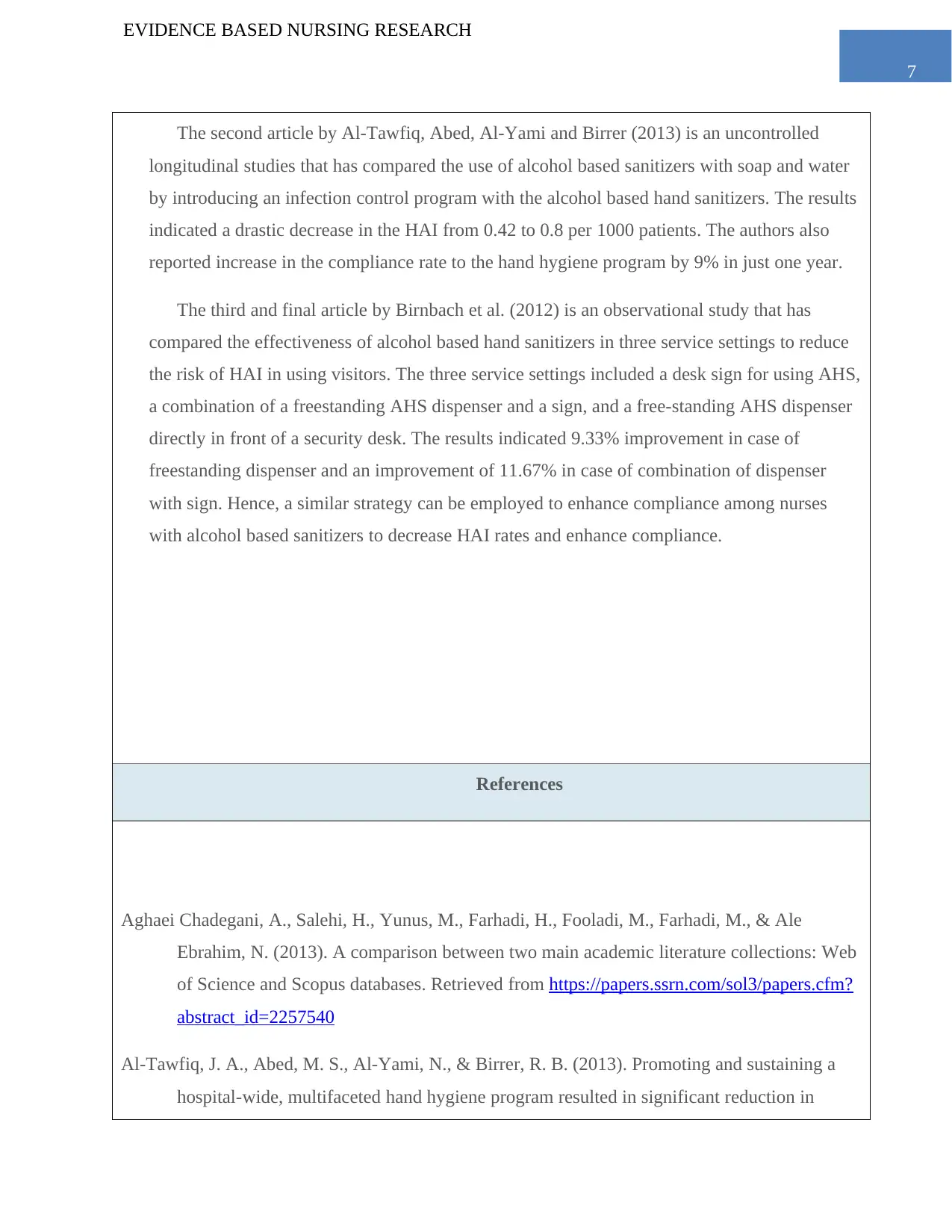
7
EVIDENCE BASED NURSING RESEARCH
The second article by Al-Tawfiq, Abed, Al-Yami and Birrer (2013) is an uncontrolled
longitudinal studies that has compared the use of alcohol based sanitizers with soap and water
by introducing an infection control program with the alcohol based hand sanitizers. The results
indicated a drastic decrease in the HAI from 0.42 to 0.8 per 1000 patients. The authors also
reported increase in the compliance rate to the hand hygiene program by 9% in just one year.
The third and final article by Birnbach et al. (2012) is an observational study that has
compared the effectiveness of alcohol based hand sanitizers in three service settings to reduce
the risk of HAI in using visitors. The three service settings included a desk sign for using AHS,
a combination of a freestanding AHS dispenser and a sign, and a free-standing AHS dispenser
directly in front of a security desk. The results indicated 9.33% improvement in case of
freestanding dispenser and an improvement of 11.67% in case of combination of dispenser
with sign. Hence, a similar strategy can be employed to enhance compliance among nurses
with alcohol based sanitizers to decrease HAI rates and enhance compliance.
References
Aghaei Chadegani, A., Salehi, H., Yunus, M., Farhadi, H., Fooladi, M., Farhadi, M., & Ale
Ebrahim, N. (2013). A comparison between two main academic literature collections: Web
of Science and Scopus databases. Retrieved from https://papers.ssrn.com/sol3/papers.cfm?
abstract_id=2257540
Al-Tawfiq, J. A., Abed, M. S., Al-Yami, N., & Birrer, R. B. (2013). Promoting and sustaining a
hospital-wide, multifaceted hand hygiene program resulted in significant reduction in
EVIDENCE BASED NURSING RESEARCH
The second article by Al-Tawfiq, Abed, Al-Yami and Birrer (2013) is an uncontrolled
longitudinal studies that has compared the use of alcohol based sanitizers with soap and water
by introducing an infection control program with the alcohol based hand sanitizers. The results
indicated a drastic decrease in the HAI from 0.42 to 0.8 per 1000 patients. The authors also
reported increase in the compliance rate to the hand hygiene program by 9% in just one year.
The third and final article by Birnbach et al. (2012) is an observational study that has
compared the effectiveness of alcohol based hand sanitizers in three service settings to reduce
the risk of HAI in using visitors. The three service settings included a desk sign for using AHS,
a combination of a freestanding AHS dispenser and a sign, and a free-standing AHS dispenser
directly in front of a security desk. The results indicated 9.33% improvement in case of
freestanding dispenser and an improvement of 11.67% in case of combination of dispenser
with sign. Hence, a similar strategy can be employed to enhance compliance among nurses
with alcohol based sanitizers to decrease HAI rates and enhance compliance.
References
Aghaei Chadegani, A., Salehi, H., Yunus, M., Farhadi, H., Fooladi, M., Farhadi, M., & Ale
Ebrahim, N. (2013). A comparison between two main academic literature collections: Web
of Science and Scopus databases. Retrieved from https://papers.ssrn.com/sol3/papers.cfm?
abstract_id=2257540
Al-Tawfiq, J. A., Abed, M. S., Al-Yami, N., & Birrer, R. B. (2013). Promoting and sustaining a
hospital-wide, multifaceted hand hygiene program resulted in significant reduction in
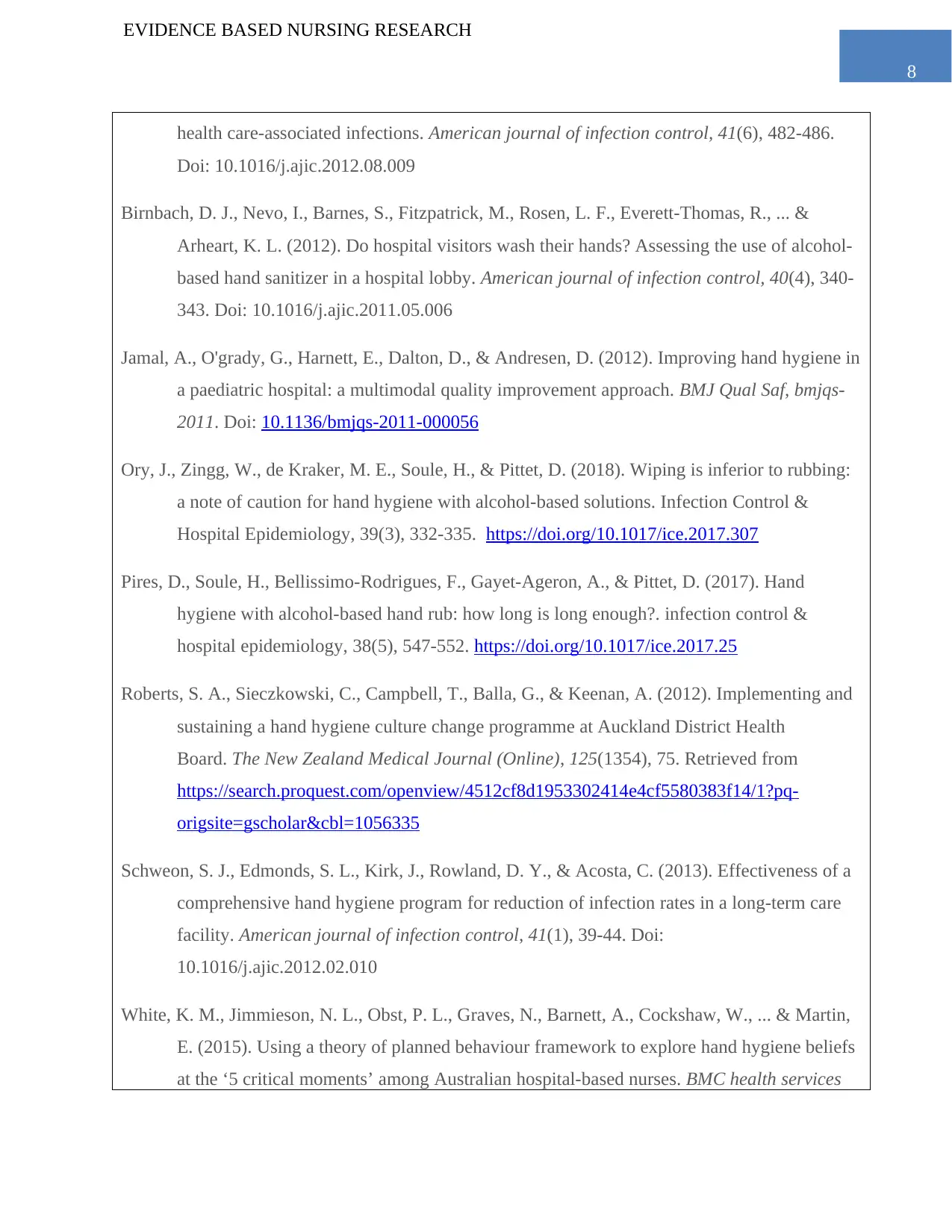
8
EVIDENCE BASED NURSING RESEARCH
health care-associated infections. American journal of infection control, 41(6), 482-486.
Doi: 10.1016/j.ajic.2012.08.009
Birnbach, D. J., Nevo, I., Barnes, S., Fitzpatrick, M., Rosen, L. F., Everett-Thomas, R., ... &
Arheart, K. L. (2012). Do hospital visitors wash their hands? Assessing the use of alcohol-
based hand sanitizer in a hospital lobby. American journal of infection control, 40(4), 340-
343. Doi: 10.1016/j.ajic.2011.05.006
Jamal, A., O'grady, G., Harnett, E., Dalton, D., & Andresen, D. (2012). Improving hand hygiene in
a paediatric hospital: a multimodal quality improvement approach. BMJ Qual Saf, bmjqs-
2011. Doi: 10.1136/bmjqs-2011-000056
Ory, J., Zingg, W., de Kraker, M. E., Soule, H., & Pittet, D. (2018). Wiping is inferior to rubbing:
a note of caution for hand hygiene with alcohol-based solutions. Infection Control &
Hospital Epidemiology, 39(3), 332-335. https://doi.org/10.1017/ice.2017.307
Pires, D., Soule, H., Bellissimo-Rodrigues, F., Gayet-Ageron, A., & Pittet, D. (2017). Hand
hygiene with alcohol-based hand rub: how long is long enough?. infection control &
hospital epidemiology, 38(5), 547-552. https://doi.org/10.1017/ice.2017.25
Roberts, S. A., Sieczkowski, C., Campbell, T., Balla, G., & Keenan, A. (2012). Implementing and
sustaining a hand hygiene culture change programme at Auckland District Health
Board. The New Zealand Medical Journal (Online), 125(1354), 75. Retrieved from
https://search.proquest.com/openview/4512cf8d1953302414e4cf5580383f14/1?pq-
origsite=gscholar&cbl=1056335
Schweon, S. J., Edmonds, S. L., Kirk, J., Rowland, D. Y., & Acosta, C. (2013). Effectiveness of a
comprehensive hand hygiene program for reduction of infection rates in a long-term care
facility. American journal of infection control, 41(1), 39-44. Doi:
10.1016/j.ajic.2012.02.010
White, K. M., Jimmieson, N. L., Obst, P. L., Graves, N., Barnett, A., Cockshaw, W., ... & Martin,
E. (2015). Using a theory of planned behaviour framework to explore hand hygiene beliefs
at the ‘5 critical moments’ among Australian hospital-based nurses. BMC health services
EVIDENCE BASED NURSING RESEARCH
health care-associated infections. American journal of infection control, 41(6), 482-486.
Doi: 10.1016/j.ajic.2012.08.009
Birnbach, D. J., Nevo, I., Barnes, S., Fitzpatrick, M., Rosen, L. F., Everett-Thomas, R., ... &
Arheart, K. L. (2012). Do hospital visitors wash their hands? Assessing the use of alcohol-
based hand sanitizer in a hospital lobby. American journal of infection control, 40(4), 340-
343. Doi: 10.1016/j.ajic.2011.05.006
Jamal, A., O'grady, G., Harnett, E., Dalton, D., & Andresen, D. (2012). Improving hand hygiene in
a paediatric hospital: a multimodal quality improvement approach. BMJ Qual Saf, bmjqs-
2011. Doi: 10.1136/bmjqs-2011-000056
Ory, J., Zingg, W., de Kraker, M. E., Soule, H., & Pittet, D. (2018). Wiping is inferior to rubbing:
a note of caution for hand hygiene with alcohol-based solutions. Infection Control &
Hospital Epidemiology, 39(3), 332-335. https://doi.org/10.1017/ice.2017.307
Pires, D., Soule, H., Bellissimo-Rodrigues, F., Gayet-Ageron, A., & Pittet, D. (2017). Hand
hygiene with alcohol-based hand rub: how long is long enough?. infection control &
hospital epidemiology, 38(5), 547-552. https://doi.org/10.1017/ice.2017.25
Roberts, S. A., Sieczkowski, C., Campbell, T., Balla, G., & Keenan, A. (2012). Implementing and
sustaining a hand hygiene culture change programme at Auckland District Health
Board. The New Zealand Medical Journal (Online), 125(1354), 75. Retrieved from
https://search.proquest.com/openview/4512cf8d1953302414e4cf5580383f14/1?pq-
origsite=gscholar&cbl=1056335
Schweon, S. J., Edmonds, S. L., Kirk, J., Rowland, D. Y., & Acosta, C. (2013). Effectiveness of a
comprehensive hand hygiene program for reduction of infection rates in a long-term care
facility. American journal of infection control, 41(1), 39-44. Doi:
10.1016/j.ajic.2012.02.010
White, K. M., Jimmieson, N. L., Obst, P. L., Graves, N., Barnett, A., Cockshaw, W., ... & Martin,
E. (2015). Using a theory of planned behaviour framework to explore hand hygiene beliefs
at the ‘5 critical moments’ among Australian hospital-based nurses. BMC health services
⊘ This is a preview!⊘
Do you want full access?
Subscribe today to unlock all pages.

Trusted by 1+ million students worldwide

9
EVIDENCE BASED NURSING RESEARCH
research, 15(1), 59. Doi: 10.1186/s12913-015-0718-2
WHO | Alcohol-Based Handrub Risks/Hazards. (2018). Clean Care is Safer Care. Retrieved from
http://www.who.int/gpsc/tools/faqs/abhr2/en/
EVIDENCE BASED NURSING RESEARCH
research, 15(1), 59. Doi: 10.1186/s12913-015-0718-2
WHO | Alcohol-Based Handrub Risks/Hazards. (2018). Clean Care is Safer Care. Retrieved from
http://www.who.int/gpsc/tools/faqs/abhr2/en/
Paraphrase This Document
Need a fresh take? Get an instant paraphrase of this document with our AI Paraphraser

10
EVIDENCE BASED NURSING RESEARCH
EVIDENCE BASED NURSING RESEARCH
1 out of 11
Related Documents
Your All-in-One AI-Powered Toolkit for Academic Success.
+13062052269
info@desklib.com
Available 24*7 on WhatsApp / Email
![[object Object]](/_next/static/media/star-bottom.7253800d.svg)
Unlock your academic potential
Copyright © 2020–2025 A2Z Services. All Rights Reserved. Developed and managed by ZUCOL.





